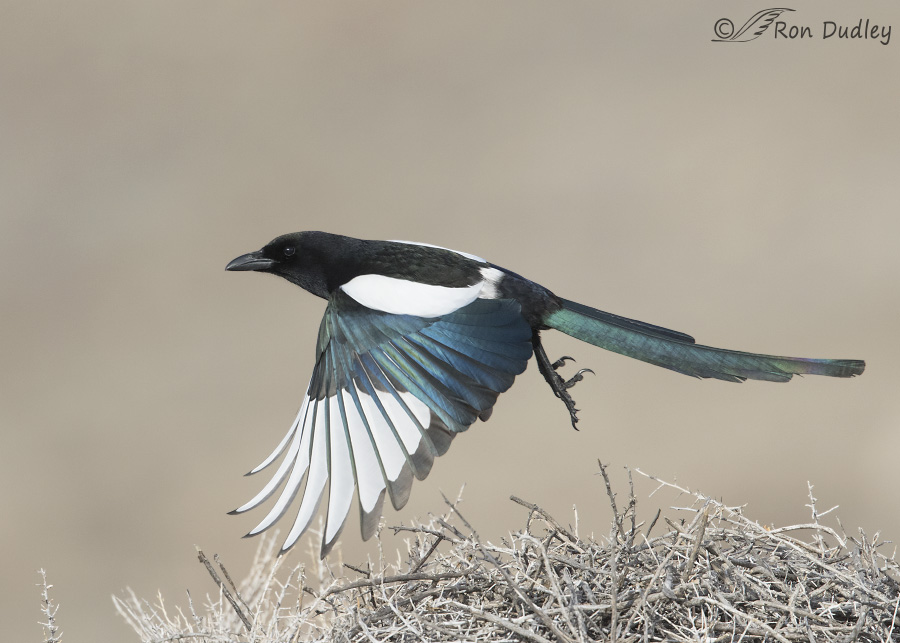Local Black-billed Magpies are already showing interest in spring activities.
 1/3200, f/6.3, ISO 800, Canon 7D Mark II, Canon EF 500mm f/4L IS II USM + 1.4 tc, not baited, set up or called in
1/3200, f/6.3, ISO 800, Canon 7D Mark II, Canon EF 500mm f/4L IS II USM + 1.4 tc, not baited, set up or called in
At least some of them have begun refurbishing old nests in preparation for raising this year’s brood. I found this one atop one of those nests yesterday morning on Antelope Island and since magpies are one of my favorite subjects I couldn’t resist snapping off a few shots from a respectable distance.
One of my goals with magpies is to capture their spectacular iridescence but that isn’t easy to do because the light has to be at just the right angle for it to appear. I’ve learned where to place myself in relation to the sun to improve my chances and this time I got lucky. I find it interesting that iridescence is found only on the dorsal surfaces of the wings and tail and not on the other blacks of the body.
That makes me wonder about the evolution of iridescence and its functional advantage to species that have it.
Ron


I wondered if the iridescence was for protection. The view from above would make it seem as if the bird was not really a bird. I think of the wings blending into the sky colors.
Beautiful shot!
Gorgeous shot Ron!
Charlotte
How I love seeing photos of YOUR magpies, whose beauty puts ours in the shade. Their cheeky natures seem to match though.
EC, our magpies aren’t so flashy either when you can’t see the iridescence – which is nearly all of the time.
Soory about iPad comment…it was giving me more than usual grief…another beautiful image of a very elegant if mischievious bird…one of my favorites…love the black lines flight feathers and the iridescence….
Thanks, Patty. Your relationship with that iPad may give you endless grief but it can be pretty amusing on this end…
Just tryimpng GD iPad
Loved that link, thanks Ron ! As an artist who has worked with structural ( interference ) color media for many years , I can especially appreciate how
confusing this feature must be to a predator–it is the ultimate in “shape-shifting”, even if the carrier of iridescence hasn’t moved at all . If the viewer
( in this case a potential predator ) has itself moved, even if only its head-position, that flash of light and color may have disappeared, leaving the “question”
did the perception actually occur in reality ? That evanescent quality is certainly part of its charm–but probably not if you’re looking for a meal !
Interesting point about the confusion factor of iridescence on potential predators, Kris. I can vouch for the fact that it usually takes VERY little change on position or angle for either the bird or the viewer to alter iridescence or make it disappear. Pretty amazing, actually.
At the risk of repetitive redundancy, yet again, WOW! What a lovely image for this dreary morning.
I’ve wondered regularly about the why of the iridescence, too. I’m sure there’s a very good reason from the birds’ perspective, well beyond what we see as outrageously pretty. I also know they see things differently than us. But that’s as far as I can go with that until Merlin shows up with a working magic wand that will transport us into their perspective. All I’ve got is this lousy stick that doesn’t allow me to go anywhere! Harrumph!
As you know, I’m a major fan of the whole darn corvid famly! Each and every one of them rock!
Laura, I’ve been doing some preliminary research on the functions of iridescence this morning – wow, it’s incredibly varied and quite interesting. Here’s a link if anyone’s interested – http://www.ncbi.nlm.nih.gov/pmc/articles/PMC2706478/
Ron: Great, beautiful shot. I appreciate it even more knowing it is a “black and white” bird, moving fast, that does not like you to get too close. And you even got an eye highlight!
Thanks, Richard. As you know, eye catch lights are very important in bird photography but when the head and eye are both black or dark and you don’t have light in the eye that entire area looks like a photon-sucking black void. IMO, catch lights are essential in those situations.
The iridescence is beautiful – every animal/bird has to have redeeming features! They sure can make a mess (from a lawn mowing standpoint)when remodeling a nest or raiding an old one to build a new one – have to admire their work ethic tho.
They sure can make a mess (from a lawn mowing standpoint)when remodeling a nest or raiding an old one to build a new one – have to admire their work ethic tho.
I can tell you’re very familiar with them, Judy – they do all the things you describe.
Nothing simple about the iridescence for sure according to the link! Think I’ll just enjoy it!
Think I’ll just enjoy it! 